Catheterization
Catheterization requires the insertion of a thin tube called a catheter into your urethra to drain urine collected in your bladder. There are a variety of types of catheters and its important you discuss with your health care provider which is the best type for you.

Since you usually need to empty your bladder a few times a day you will have to catheterize at varying times or intermittently throughout the day. To make the self-catheterization process easier, you should use a sterile lubricating gel. Cathejell® is a sterile lubricating gel in an accordion syringe with an anesthetic (an ingredient that numbs an area from pain), which is injected into your urethra before putting the catheter into the urethra, to reduce the risk of pain and injury to the urethra.
Your doctor may recommend that you insert a catheter at home (called intermittent self-catheterization) if you have: 1
- Urinary retention (inability to drain urine from your bladder normally)
- Urinary incontinence (inability to control release of urine from your bladder)
- A medical condition such as multiple sclerosis or a spinal cord injury that prevents you from emptying your bladder
- Temporary urinary retention during recovery from surgery.
Reducing the Risk of Injury
For many people intermittent self-catheterization is managed with little difficulty, pain, or injury. However, catheterization does have its risks since you have to catheterize a few times a day. It is common to have urethral bleeding, urethritis, or inflammation of the urethral opening from frequent catheter insertion. Other more serious events can occur resulting in urethral injury and pain.8 Therefore, it is important to get instruction from your doctor or nurse and have meetings with them if you are having any difficulties. Proper techniques with the right catheter and lubrication can help avoid the risk of injury and pain. It is a good idea to familiarize yourself with the procedure and the anatomy involved.2
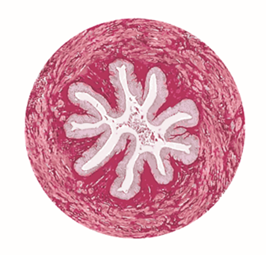
Basic Anatomy Of The Urethra
The urethra is like a tube which transports urine from the bladder to exit outside the body.
The urethra in men and women is not open inside like a hose; nice and smooth. Instead, there are flattened folds inside that expand to open the urethra only when you urinate.3 Normally the urethra is closed. See Figure 3, which shows a cross-section view of a closed urethra. Note all the folds in the lining that could be damaged when putting a catheter inside.
The tissue lining the urethra is sensitive, rich in nerves and blood vessels and not very stretchable.4 Pain when catheterizing is caused by the stretching of the urethra when the catheter enters the urethra, and the friction it creates as the catheter contacts the lining of the urethra as it moves along the urethra towards the bladder.4
Is There A Difference Between The Male And Female Urethra?
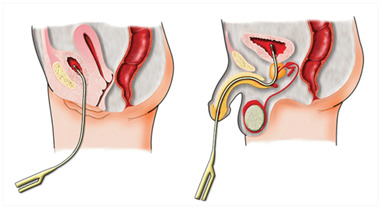
The male urethra is approximately 15 to 25 cm long and follows a path that curves around the prostrate before it enters the bladder. This makes catheter insertion a little more difficult and makes it easier to cause injury when trying to push the catheter into the bladder.5
The female urethra is shorter (approximately 3-4 cm) and is mostly in a straight line to the bladder.6
Use of a lubricating jelly or lubricating jelly with an anesthetic, an ingredient that numbs an area from pain, can minimize the pain and reduce the risk of injury when catheterizing.2,7
Benefits Of Instillation With A Lubricant
To put lubricating gel directly into the urethra is called instilling the gel or instillation.
There are two common lubrication methods to help put a catheter into the urethra:
1. Coating the outside of a catheter with lubrication before inserting into a urethra.
Coating only the outside or tip of the catheter with a lubricant may not be enough to protect the urethra from injury. This is because much of the lubricant is often pushed off the outside of the catheter as the catheter is pushed into the urethra. This means less lubricant is going into the urethra to protect the lining of the urethra.1
Once the catheter is inserted into the urethra, the portion of the urethra in front of the catheter is still closed. This means that the catheter must force the urethra to open. This results in an increased risk of pain from stretching the urethra with the catheter or injury from friction caused by the catheter and contact with the lining.4
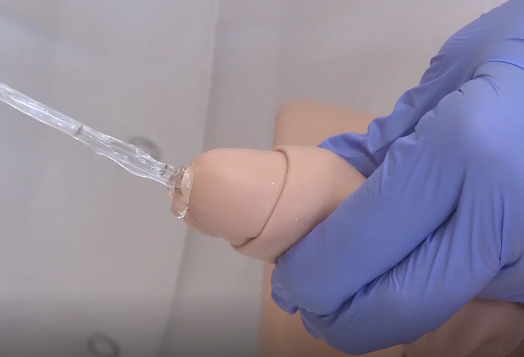
2. Instilling lubrication directly into the urethra before inserting the catheter.
Putting lubrication into the urethra before inserting the catheter reduces the risk of injury to the delicate lining of the urethra.2,3 By putting the lubricant directly into the urethra it is possible to get a more even coating of the lining of the urethra with lubricant. Now the urethra which is normally closed, is gently opened by the lubricating gel and kept open in front of the catheter. This makes a lubricated path for the catheter to follow and reduces the risk of pain and injury.2,6
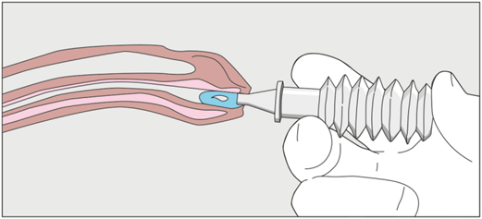
How is Intermittent Self-Catheterization Performed?2
This is a basic outline of how to do intermittent self-catheterization when using a syringe of Cathejell® sterile lubricant. You should get training instruction from your doctor or nurse about the process before trying it yourself.
- First you should wash your hands with soap and water then dry them.
- Prepare your catheterizing materials for use, taking care to keep them clean and sterile.
- Position yourself sitting on a toilet or facing the toilet, whichever you prefer. In males, if uncircumcised, pull back the foreskin and in females spread your labial lips, then wash around the urethral opening with a clean cloth, soap, and warm water.
- Once that is done a drop of Cathejell® is applied to the urethral opening to enable the smooth and rounded cone of the Cathejell syringe to be easily inserted in the urethra. Cathejell® is then slowly injected into the urethra. The injection of Cathejell opens and expands the urethra, enabling the catheter to be inserted easier than would be the case if the lubricant were simply applied to the catheter.
- When the syringe seems to be fully compressed, maintain your pressure on the syringe to keep it compressed and then remove it from the urethra.
- To allow the anaesthetic to take full effect you should wait 5 minutes following instillation of Cathejell before inserting the catheter. However, it is still okay to proceed before that time if you do not have the time to do so. You just will not get the full benefit of the anesthetic during the insertion of the catheter.
- Once the anaesthetic has taken effect, you insert the catheter into the urethra carefully pushing it up to the bladder. It is a good idea to try stay still and relax your pelvic area while inserting the catheter as this makes it easier to insert the catheter.
- When urine starts draining from the catheter it indicates that the tip of the catheter has reached the bladder. Make sure that you have the catheter drain end over the toilet or a container to catch it.
- Once the urine has stopped coming out of the catheter, slowly remove the catheter, stopping anytime more urine begins to drain from the catheter. Uncircumcised males should replace the foreskin back over the tip the penis.
- Then dispose of your disposable catheterizing materials, clean yourself up and wash your hands.
2Adapted from: Clean Intermittent Urethral Catheterization in Adults, Canadian Best Practice Recommendations for Nurses, April 2020, Urology Nurses of Canada, https://unc.org/wp-content/uploads/2020/05/Clean-Intermittent-Urethral-Catheterization-Adults-for-Nurses-BPR-May2020-1.pdf
References
- Urinary Catheter Management, DAVID D. CRAVENS, M.D., M.S.P.H., and STEVEN ZWEIG, M.D., M.S.P.H., University of Missouri–Columbia School of Medicine, Columbia, Missouri, Am Fam Physician., 2000 Jan 15;61(2):369-376
- Clean Intermittent Urethral Catheterization in Adults, Canadian Best Practice Recommendations for Nurses, April 2020, Urology Nurses of Canada, https://unc.org/wp-content/uploads/2020/05/Clean-Intermittent-Urethral-Catheterization-Adults-for-Nurses-BPR-May2020-1.pdf
- Mary Wilson, Catheter lubrication and fixation: interventions, British Journal of Nursing, 2013, Vol 22, No 10 p 566-569
- Tzortzis et al, Intraurethral Lubricants: A Critical Literature Review and Recommendations, Journal of Endurology, Vol 23, Number 5, May 2009 p 821-826
- Male Urethra anatomy – Noah Schenkman Medscape, June 29, 2016, https://emedicine.medscape.com/article/1972482-overview#:~:text=The%20male%20urethra%20originates%20at,(see%20the%20image%20below).
- Female Urethra anatomy – Noah Schenkman, Medscape, June 27, 2016,https://emedicine.medscape.com/article/1972504-overview#a2
- Aygin D, Usta E, The effect of lubricants used in indwelling bladder catheterization through urethra on procedure-related pain: a literature review, Int J Clin Exp Med 2017;10(2):1995-2005, www.ijcem.com
- Uro Today, Diane Newman, Intermittent Catheters – complications – published URO-TODAY online – Mar 3, 2020
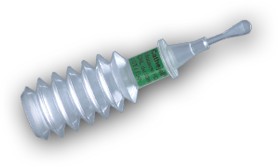

 2476 Argentia Road, Suite 402
2476 Argentia Road, Suite 402 1.888.439.0013
1.888.439.0013 905.206.1413
905.206.1413 cathejell@biosyent.com
cathejell@biosyent.com